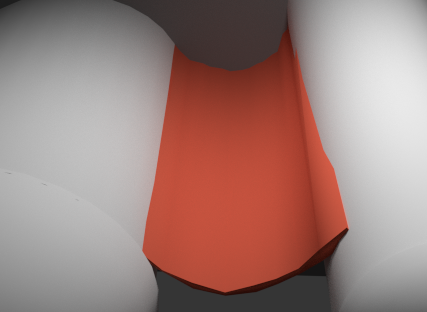When presented with the amazing complexities of a cast one can be overwhelmed at first glance. But by becoming familiar with the components that make up the complex structure that one sees on a cast one can more easily approach the task of representing such a fascinating cast. As far as I know, the structure of a cast is made up of two simple components, forms and the transitions between forms.
Identifying Forms
When looking at the hand cast shown above one can see many bulges. These bulges are called forms. A form is most often a bulge, known as a convexity, but sometimes a form is a dent, known as a concavity, seen on the surface of a three dimensional structure.
Often many of the bulges on a cast appear so subtle that it can be difficult to distinguish the boundaries of individual forms. One can consider a form's boundary to continue through the transition into another form, but in order to simplify my thought process I define a form's boundary as the ending points of a form's convexity.
 |
| This illustration used the background image taken by Snowdonia |
A form's boundary is just like the edge of a valley between mountains. The edge of the valley that defines a form's boundary may be more distinct between some forms more than others, but between the bulges of any forms there is always a boundary.
Depending on how opposed forms are and how much the forms are facing the light these boundaries can be very difficult to distinguish on a cast. To see these boundaries on a cast one just has to search for where the convexity of each form tapers off to transition into a new form to determine the boundaries of a form. To better see these boundaries it is useful to look at a form from many angles. Another thought process that I have found helpful in determining a form's boundary is to imagine spreading my fingers down in all directions from the point on a form that is most facing the light until they meet the bottom of a form's convexity.
 |
| Outlined boundaries of the large forms on the hand cast. |
Evaluating Transitions
The areas of transition between the forms on a cast connect the forms together.
 |
| A section of a transition area in red that connects two forms together. |
Specific points along a transition that are important to take note of are the ending point of convexity on a form, the middle of a transition between two forms and the beginning of the convexity of a new form. A useful analogy for evaluating the transition areas between forms is to imagine how it feels to transition from one hill on a roller coaster to another.
 |
| This illustration used the background image taken by Karyn Christner
The diagram above shows how it feels to be at different points in the transition from one hill to another on a roller coaster that is moving from the hill on the right to the hill on the left. The point where one is most scared after plummeting down the steep hill of a roller coaster would be comparable to the ending of convexity on a form. The point where one is most calm would be comparable to the end of the transition from the form that one just came down and the beginning of the transition upwards into a new hill. The point where one is beginning to feel anxious again is comparable to the bottom of the convexity on a new form before it begins to turn upwards towards the highest point on the hill. This roller coaster analogy was helpful to me while I evaluated the transitions between forms on the hand cast.
|

No comments:
Post a Comment